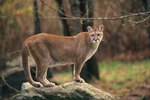
Coyotes are related to dogs and resemble a German shepherd. They have long, narrow faces and black-tipped pointy ears. Their long and bushy tails are held downward. The coyote's fur is light brown, brown, red, gray or a variation of these. Coyotes live throughout North America and down into Panama. Coyotes found west of the Mississippi typically weigh 15 to 25 pounds while those found east of the Mississippi weigh up to 40 pounds.
The Adaptable Coyote

The coyote's natural habitat is grassland, but he changes his diet, breeding habits and social behavior in order to survive in a new environment. He adapts to desert scrub, mountains, mesas, valleys, forests, swamps and populated neighborhoods. The coyote is an opportunist and goes wherever he can find food. He travels alone, in pairs or in small packs, covering an average of 100 miles a day with a range of 12 square miles.
Coyote Dens

Coyotes do not hibernate, but they do sleep and give birth in their dens. The den is a burrow dug under a tree, bush or ledge. Dens in populated areas are found under sheds or in storm drains. The entrances are usually well hidden. Coyotes breed in February and March with an average four to eight pups per litter. The mother stays in the den with the pups for their first 11 days.
The Coyote's Diet

Coyotes are scavengers and their diets change with the seasons. They eat birds, rabbits, rodents, lizards, insects, small mammals, including small dogs and cats, small deer, carrion, mesquite beans, cactus fruit, persimmons and even garbage. Coyotes are excellent hunters. They run up to 40 mph and have a superb sense of smell, hearing and eyesight. Coyotes often hunt alone for smaller prey and hunt in small packs to bring down larger prey, such as a deer.
Enemies of the Coyote

Coyotes have been hunted by man for more than 200 years. Man's construction and road building contribute to loss of habitat. Coyote deaths are caused by traffic. Coyotes are not attacked by many wild animals, but they are occasionally victims of bears, mountain lions and wolves. Coyotes can suffer from rabies, distemper, parvo and other diseases. They are often carriers of lice, mites, fleas, ticks, mange, heartworms and other parasites. Coyotes live an average of 12 years.
References
Photo Credits
-
Jupiterimages/Photos.com/Getty Images
Writer Bio
Karen Mihaylo has been a writer since 2009. She has been a professional dog groomer since 1982 and is certified in canine massage therapy. Mihaylo holds an associate degree in human services from Delaware Technical and Community College.




